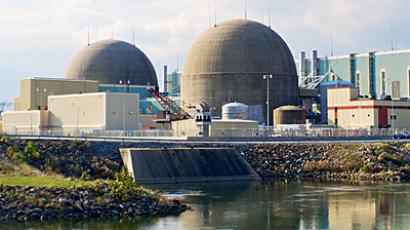Nuclear plant alert as 26 facilities in Sandy's path

Parts of two nuclear power plants were shut down and another one put on alert, as the ‘Superstorm’ Sandy ravished the US East Coast. The storm may hit as many as 26 of the nuclear facilities along its path.
At the Salem plant in Hancocks Bridge, New Jersey, a unit was shut down Tuesday, because four of its six circulating water pumps were no longer available, PSEG Nuclear reported. The plant's other unit, Salem 2, was already offline for maintenance when the storm hit.A unit at Indian Point plant north of New York City was shut down on Monday due to an external grid issue, the plant operator said. The facility itself and its employees are not at risk, the Entergy Corp. said.America's oldest nuclear power plant at Oyster Creek was already out of service for scheduled refueling when the storm hit. The Nuclear Regulatory Commission (NRC) officials have put the facility on alert due to unusually high water there. The agency assured that the water levels are expected to recede soon and pose no threat to the plant.But Professor Christopher Busby from the European Committee on Radiation Risks says that Oyster Creek – which was commissioned in 1969 – could pose danger because of its age.“The older the nuclear power station, the less good the integrity of the various control systems and the actual metallic components of the control systems…if they’re that much older, they’re more corroded. They can be brittle as a result of neutron effects. So that’s certainly a factor,” Busby told RT.In other parts of the East Coast, nuclear plants were weathering the storm without incident.
Arnie Gundersen, the chief engineer of energy consulting company Fairewinds Associates, warns in a recent podcast that even if engineers at plants from North Carolina to New England say their plants have been shut down and are safe from disaster, it may already be too late.During a recording uploaded to the Fairewinds website on October 28, the nuclear expert explains that facilities that are shut-down in preparation of severe storms like Sandy could still contain dangerous radioactive materials in their cooling pools for as long as two days. “The plant can withstand relatively high winds, but the transmission grid can’t — that’s all those transmission towers that are all over the states,” Gundersen says. “So what’s like to happen is that power lines will go down and the plant will suffer what will call loss of offsite power,” the same thing that happened at Fukushima, Japan.Gundersen says that once offsite power is shut down, plants will automatically halt its nuclear chain reaction process because that energy will have nowhere to go. “The plant needs to drop its power immediately because there is no wire at the other end to send it anywhere if the offsite power is lost,” he says.“There’s 26 power plants in the East Coast that are in the area where sandy is like to hit, and hopefully as the storm track becomes better defined, the plants that are most subject to it — likely New Jersey and Pennsylvania — preventively shut down,” Gundersen says. Assuming those facilities preemptively put their nuclear plans on hold, he adds, “will of course minimize the impact: the jarring to the nuclear reactor and its safety systems.”But even if plants are shut down, though, onsite power will need to be pushed somewhere, which then raises an entirely independent question of how to handle a surplus of radioactive, intense energy.“When offsite power is lost, the plant is forced to dramatically reduce power real quickly and then it still needs to be cooled,” he says.“You’ll hear in the next two days, ‘we’ve shut down the plant,’” he says, “but what that means is they stopped the chain reaction. But what Fukushima taught us was that that doesn’t stop the decay heat. There is still as much as 5 percent of the power from the power plant that doesn’t go away when the plant shuts down, and for that you need the diesels to keep the plant cool,” referring to the diesel-powered generators that will control the reservoirs. “Some of these plants have two diesels, and some of these have three diesels, and they are designed so that if one of these fails then they can still get by,” he says. “As the plant operator, as the people running the plant, it’s a little bit of a nervous time to realize that you’re on your last fall-back,” he warns. “You just hope that’s your last fall-back.” Even if pools can still be powered and cooled, that doesn’t mean that a chance of a disaster is nil: according to a McClatchy report from 2011, the cooling pool used in the US contain much more nuclear material on average than those in Japan.Some facilities in the storm’s trajectory, such as the nation’s oldest nuclear plant — Oyster Creek in Lacey, New Jersey — have already pulled the plug for other reasons. In that case, routine maintenance has already allowed the facility a few days to cool down and will likely spare South Jersey from any otherwise imminent disaster. Across the East Coast, though, other sites might still pose a risk.Speaking to Bloomberg News, Nuclear Regulatory Commission spokesman Neil Sheehan says the agency is prepared to see “an impact to coastal and inland plants” and is planning on stationing inspectors at plants expected to be hit.














